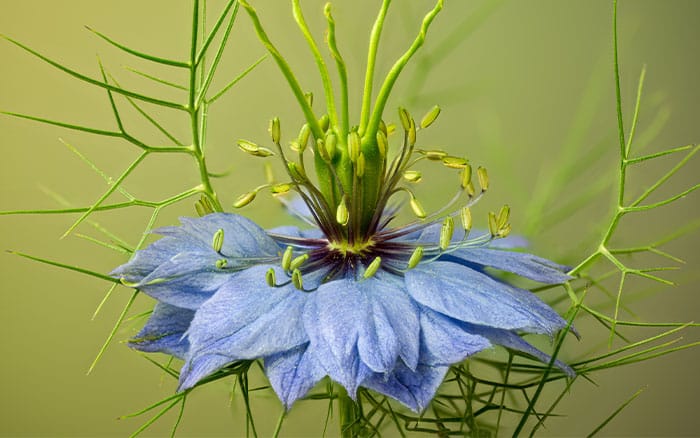Love-in-a-mist, or Nigella, are lovely plants with a magical appearance worth adding to your garden. Find out everything you need to know to grow them successfully in your garden.
Plant Biography

BOTANICAL NAME
Nigella, Nigella damascena
COMMON NAME
It has a number of different common names, valerian, all-heal, cat’s valerian, cut-finger, cut-heal, garden heliotrope, hardy heliotrope, Hercules’ all-heal, medicinal valerian, set-well, St George’s herb, summer heliotrope, Vandal root and herb bennet. The common name of cat’s valerian is because cats love it!
It should not be confused with another plant with the common name red valerian. It is not a valerian at all and belongs to the genus Centranthus.
NATIVE TO
Love-in-a-mist, Bird’s nest, Blue spiderflower.
DESCRIPTION
These delicate little garden annuals have an almost ethereal effect thanks to their lacelike foliage peeking behind the blooms. This is where the inspiration behind their charming names was taken. The blooms are followed by large seedheads, made more attractive by the filigree foliage on the stems.
What colours does it come in?
Typically, you will see Love-in-a-mist as a delicate shade of blue, but other options are available. Shades vary from light to bright blue, white, pink, or lavender. Some varieties, like Nigella damascena ‘Miss Jekyll Alba’ have predominantly white petals with a bright spark of pink in the centre.




Where does it like to grow?
Make sure you choose a sunny position for these light-loving plants, with well-draining soil. Try to ensure they are in a sheltered position, as whilst they are hardy annuals, they don’t particularly like very cold conditions.
Where does it dislike to grow?
These plants won’t be particularly happy in poor, heavy soil, preferring free-draining conditions.
How to grow Love-in-a-mist successfully

Before sowing, ensure the soil is well draining, and if not, dig a little horticultural grit into it to improve it. If the soil is particularly dry, it is worth watering before Their black seeds can be sown directly where you want the plant to flower.
Make sure once you have sown them, you cover them with a centimetre of soil. When sowing directly outdoors, do so between March and April, once the risk of frost has passed.
Once seedlings start to appear, your plants will benefit from being thinned out, giving each more space to grow and thrive, ensuring they are sturdier. Thin them to between 10 and 15 centimetres apart for best results.
They will eventually start flowering between July and the end of August. You can encourage further flowers by deadheading any spent flowerheads unless you want to allow the seed heads to develop for your autumn garden displays.
They will die back in autumn/winter, where if you have left the seedheads to develop, they may self-seed to grow again the following spring.
Is it good for pollinators?
How to choose the right Love-in-a-mist for your garden
Each Love-in-a-mist plant tends to have very similar growing conditions and sizes, so you will likely find the deciding factor is the colour you would prefer.
How big will it get
These annuals typically won’t grow any taller than 50 cm, and each individual flower will measure about 4 cm across.

How to plant Love-in-a-mist
Love-in-a-mist is best grown and propagated outdoors via seed, rather than being planted as established plants.
How to care for Love-in-a-mist
Love-in-a-mist are very low-fuss and have very few requirements. Once sown and established, just water once the soil dries out. They don’t require feeding, or overwintering as they are annuals.
Deadheading is optional, although the seedheads also make an attractive feature.
How to keep it looking good
If you want more flowers rather than the display from the seedheads, deadhead any spent flowers to give the plant more energy to produce more within the flowering season.
Otherwise, these plants still look very attractive when left to their own devices.

How to propagate Love-in-a-mist
Love-in-a-mist is propagated by seed. They are capable of self-seeding, or you can collect the seeds from the seedheads once they have matured. Sow these in September for a spring display, or between March and April for a July-August feature.
What problems can Love-in-a-mist have?
These lovely flowers are pretty problem-free. Generally, they have no pest or disease problems. Plus, they are hardy during their flowering time.
Varieties of Love-in-a-mist to have
Nigella damascena ‘Miss Jekyll’ is the classic Love-in-a-mist variety, with the semi-double cornflower-blue flowers. Another variety very similar to this has already been mentioned, ‘Miss Jekyll Alba’, which is a white variety of this flower.
A lovely red and pink variety with lots of varying shades for added texture is Nigella damascena ‘Mulberry Rose’. Or if a darker blue variety is your preferred choice, Nigella damascena ‘Oxford Blue’ is a gorgeous flower to enjoy.




Best time of year to buy this plant
You can buy Love-in-a-mist seeds year-round, just ensure to sow them at the appropriate times.
The best garden design style for Love-in-a-mist
These lovely Nigella plants are best suited to cottage-style gardens.


Leave A Comment